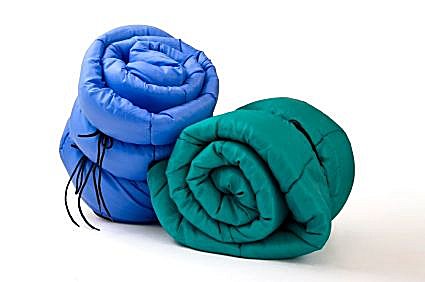How to Clean Sleeping Bags
Whether Sleeping Bags are filled with down or synthetic-fibers, dirt, grime and body oils can affect their ability to keep a sleeping person warm. As the children return from summer camp, you’ll want to make sure their sleeping bags are thoroughly cleaned before you put them away until next year. Always check the manufacturer’s tag for care instructions before cleaning.
Washing & Care
Cleaning Sleeping Bags should always take place after use. The following information will help you keep your sleeping bag clean and provide information on the proper use and storage — ensuring that your sleeping bag keeps you warm at night and lasts a long time.
Now it’s not easy to clean a Sleeping Bag, and so to reiterate, the best way to clean a sleeping bag is to bring it to Bibbentuckers. We are experts in cleaning sleeping bags and you will get it returned as close to new as possible.
Read the Care Label
Always read the manufacturer’s care labels for the proper way to clean your sleeping bag. Normally, the label will tell you to NEVER DRY CLEAN your sleeping bag. This occurs because Dry cleaning strips down natural, protective oils, clogs the pores of technical fabrics and will void your warranty. If you use Bibbentuckers, you will not have to worry about the cleaning of your Sleeping Bag.
Treating Small Stains on Sleeping Bags
- Use any mild, non-detergent soap or non-bleach stain treater
- Shake the down away from the spot you are treating and, using a clean terry cloth saturated with soap and water, gently scrub the stain until it fades
- Wipe the area with a clean, damp cloth to clear away the soap residue
- Make sure the item is completely dry before storing it
Washing Machines
- Use the largest front-loading commercial washer you can find. Do not use top-loading washers with agitators; they will damage your garment or sleeping bag
- Use down soap as they are specially formulated cleaners will help to preserve the natural oils in the down while still getting your item clean and restoring its loft. In a pinch, you can use mild, non-detergent soap diluted with water.
- Never use bleach, bleach-alternatives or fabric softener.
- Apply soap directly to heavily soiled or stained areas and soak for up to one hour
- Be sure to turn garments and sleeping bags inside out prior to washing.
- Water will escape through the lining material more easily than it will through the water-resistant or waterproof shell material during the spin cycle
- Use the normal, cold water cycle, with a cold water rinse
- Run through a complete second cycle without soap. This will ensure removal of all soap residue
- Carefully wring as much water out of the bag as possible before attempting to lift it.
- The down in your sleeping bag will be heavy when wet, making it easier to tear the fabric of the sleeping bag if not handled carefully
Washing Sleeping Bags by Hand
- Fill a large wash basin or bathtub with cold water
- Use down soap. Never use bleach, bleach-alternatives or fabric softener
- Apply soap directly to heavily soiled or stained areas and soak for up to one hour
- Gently knead the item from one end to the other making sure that all of the down is soaked and there are no air pockets
- Rinse several times with cold water until the water runs clear — indicating the removal of any soap
- Carefully wring as much water out of the bag as possible before attempting to lift it
Drying
Drying can easily be the most time intensive step in cleaning down items. This is especially true with larger down garments like sleeping bags where the drying process can typically take several hours. It is important to dry your down products properly, and not to cut corners. For maximum effectiveness, do not flat or hang dry down items.
- Move your product from washer to the dryer. Always carefully carry down products from the underside while they are saturated with water
- Use the largest front-loading commercial dryer you can find, set to medium heat
- During the drying process, periodically go through the item and manually break up the clumps of down that have formed during the wash process
- Make sure your items are completely dry before storing them
Water Repellant Fabric Replenishment
Once every couple of years, the Water Repellant finish that is used on sleeping bags needs to be replenished. If you notice that water is no longer beading up on the surface of the sleeping bag, wash the item and then dry it on medium heat for 30-45 minutes to re-activate the water repellent condition. If this doesn’t work, you will need to apply a water repellent replenishing treatment and there are many good ones on the market. OR as we said before, bring the sleeping bag to any one of our Bibbentuckers locations and we will ensure it is properly washed, dried and stays water repellent.





